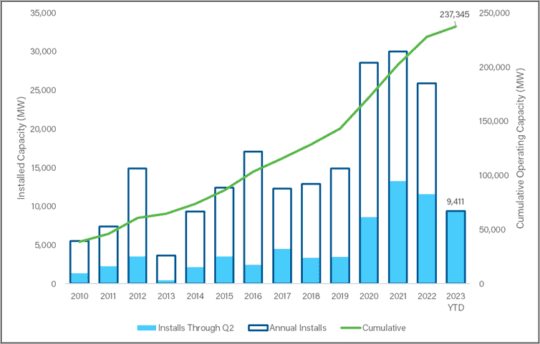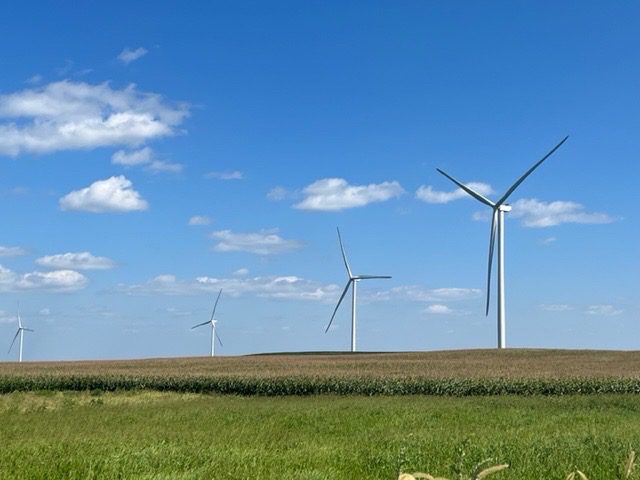The future looks bright again for clean energy. After a sluggish first quarter, the renewable energy industry in the U.S. saw installations propel to the second-highest on record in the second quarter, according to a recent report by the American Clean Power Association (ACP).
The total power brought online was 5.2 gigawatts from 105 projects – enough to supply renewable energy to nearly one million U.S. households. Installations included utility-scale solar, wind, and battery storage – a positive development that helped bring installations back to 2022 levels.
Battery storage grew fastest among all energy sources, up 32% vs. the second quarter of 2022. The most significant share, however, was dominated by solar, accounting for more than 50% of total renewable energy projects.

Photo Courtesy American Clean Power Association
“Clean power installations returned to growth, with the clean energy industry logging its second-best second quarter as America forges ahead toward a clean power future,” said John Hensley, vice president of research and analytics at ACP.
“Despite persistent headwinds from regulatory, trade, and supply chain pressures, clean power project additions rebounded as developers managed through delays and worked to keep projects on schedule.”
For the first half of 2023, however, total installations declined by 19% vs. the prior-year period due to the weakness experienced at the beginning of the year. Total installs were 9.4 gigawatts during this time.

Photo Courtesy Clean Power
California contributed the most, commissioning 15% of total second-quarter installations. The second came in Texas, then Michigan. For the first half of 2023, Florida is still ahead with 1.5 gigawatts, trailed by Texas with 1.4 gigawatts and then California with 1.1 gigawatts.
Wind was the weakest among the clean energies installed in the second quarter, down 24% vs. a year ago. Solar was stable, while battery storage was the clear winner.
The good news is that there’s more in the pipeline.
The report stated that though it is still too early to view the effects of the federal initiatives on renewable energy undertaken in 2022, “their preliminary influence can be observed partially via the new-build pipeline, which encompasses 145,592 MW of clean power potential, representing both projects currently under construction and those in advanced development stages.”
The solar pipeline increased by 16% this year, representing 59% of the total project pipeline in the U.S. Battery storage pipeline grew by 45%, accounting for 15% of all projects. Meanwhile, wind initiatives rose 8% – the first increase since the third quarter of 2021.
“Over the past two years, the battery storage capacity in development has more than doubled,” stated the report. “Over the past three quarters, capacity in development has increased by an average of 14% each quarter.”

Photo Courtesy Clean Power
Currently, there are 260 storage projects in development. Fifty-six percent of those are hybrid initiatives. While impressive, the number is lower than the 70% at the end of 2022. That said, 60% of the battery storage projects that entered the pipeline in the second quarter are standalone. Those are becoming more popular as storage becomes eligible for the investment tax credit after passing the Inflation Reduction Act.
California leads this pipeline with over 9 gigawatts under development. Texas comes in second with 3.8 gigawatts of new projects. Another 29 states are developing new projects as well.
The solar pipeline saw continued stable growth in the second quarter with 848 projects equivalent to 85.3 gigawatts. Except for North Dakota and Washington, every state is involved in solar capacity development. Texas is a leader in this area, with 19.2 gigawatts under development.
“Solar has the most geographically diverse pipeline,” notes the report. “Across the country, 23 states have more than a gigawatt of solar in development, and an additional five states have more than 500 MW in development.”
Finally, the land-based wind pipeline includes 100 projects totaling 21 gigawatts. More than half are in advanced development.
“The land-based wind pipeline has been slow to refresh after record install levels in 2020 and 2021, resulting in a gradual decline in capacity in development,” the report said. “However, activity in the second quarter suggests a reversal from this trend, with the pipeline increasing 8% compared to the previous quarter.”

Photo Courtesy American Clean Power Association
Wyoming comes in first in the wind space, accounting for 23% of the total pipeline. The state has several large wind projects in development. Texas ranks second.
The technology in offshore wind power generation is also growing. New York is the leader in this pipeline, followed by New Jersey and Massachusetts.





